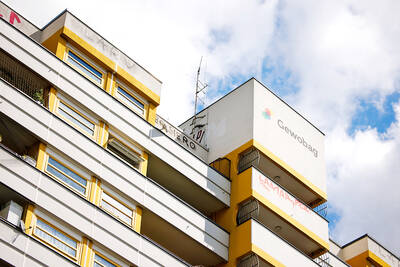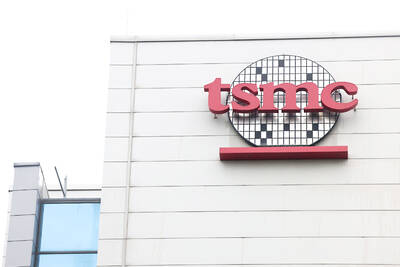The Paris Air Show opened yesterday after a four-year hiatus with the aerospace industry bouncing back from the COVID-19 pandemic, but under pressure to slash its carbon footprint.
Organizers have billed the biennial event as the “recovery air show” after COVID-19 ravaged the sector and led the event’s cancelation in 2021.
The aerospace industry is flocking back to Le Bourget airport outside Paris, as aircraft makers field hundreds of orders and airlines brace for a near-record number of passengers this year.

Photo: AFP
Russia’s war in Ukraine has also led countries to step up military spending, which could benefit aerospace defense firms.
Le Bourget, which runs until Sunday, offers a forum to announce deals with about 2,500 firms lining up to show off their latest planes, drones, helicopters and prototypes such as flying taxis.
Airbus SE chief executive Guillaume Faury, who heads France’s aerospace industry association GIFAS, called it “the return of the good old times of the excitement of the show.”
With 125,000m2 of exhibition space — the equivalent of nearly 18 soccer fields — about 320,000 visitors are expected during the week-long event.
Along with the Farnborough International Airshow in England, which takes place in even-numbered years, Le Bourget is a key sales event for the civil and defense industries.
Airbus and rival Boeing Co compete fiercely in announcing orders for aircraft running into the billions of dollars.
Airbus is in talks with Grupo Viva Aerobus SAB for a large narrow-body aircraft order that would fuel the Mexican low-cost carrier’s expansion, people familiar with the discussions said.
An order could surpass 100 aircraft, one of the people said.
Boeing is preparing to accelerate production of its cash-cow 737 jets “soon,” the planemaker’s commercial chief said, as the company makes progress toward addressing a supplier defect that has slowed deliveries.
The rate break to a 38-jet monthly pace would happen “sooner rather than later,” Boeing Commercial Airplanes CEO Stan Deal said on Sunday in Paris ahead of the industry’s biggest gathering.
At least 158 planes, helicopters and drones are to be on display, from the latest long-haul commercial jets to the F-35, the latest US stealth jet.
The US is to have a strong presence with 425 exhibitors, bolstered by renewed interest in military equipment in the aftermath of Russia’s invasion of Ukraine. Firms from 46 other nations would also be present, but not under-sanctions Russia.
China, which lifted COVID-19 restrictions at the beginning of this year, would also be represented.
However, China is not displaying its first homegrown medium-haul passenger jet, the C919, built to compete with the Airbus A320neo and Boeing 737 MAX.
The air show also hopes to open a window into the future as projects for flying taxis and other vertical takeoff aircraft abound.
Several prototypes would be on display as part of a “Paris Air Mobility” exhibition to showcase the latest innovations that developers hope will change how people travel.
French President Emmanuel Macron is to inaugurate the air show after on Friday announcing US$2.2 billion to help develop technologies to reduce aircraft emissions.
Air travel accounts for nearly 3 percent of global carbon emissions, but serves only a small minority of the world population.
With the industry targeting net zero emissions by mid-century, firms are turbocharging efforts to achieve it.
The initial focus is on sustainable aviation fuels, made from sources such as municipal waste, leftovers from the agricultural and forestry industry, crops and plants, and even hydrogen.
Companies are also working to develop battery and hydrogen-powered aircraft.
Additional reporting by Bloomberg

When an apartment comes up for rent in Germany’s big cities, hundreds of prospective tenants often queue down the street to view it, but the acute shortage of affordable housing is getting scant attention ahead of today’s snap general election. “Housing is one of the main problems for people, but nobody talks about it, nobody takes it seriously,” said Andreas Ibel, president of Build Europe, an association representing housing developers. Migration and the sluggish economy top the list of voters’ concerns, but analysts say housing policy fails to break through as returns on investment take time to register, making the

EARLY TALKS: Measures under consideration include convincing allies to match US curbs, further restricting exports of AI chips or GPUs, and blocking Chinese investments US President Donald Trump’s administration is sketching out tougher versions of US semiconductor curbs and pressuring key allies to escalate their restrictions on China’s chip industry, an early indication the new US president plans to expand efforts that began under former US president Joe Biden to limit Beijing’s technological prowess. Trump officials recently met with their Japanese and Dutch counterparts about restricting Tokyo Electron Ltd and ASML Holding NV engineers from maintaining semiconductor gear in China, people familiar with the matter said. The aim, which was also a priority for Biden, is to see key allies match China curbs the US

The popular Taiwan Semiconductor Manufacturing Co (TSMC, 台積電) arbitrage trade might soon see a change in dynamics that could affect the trading of the US listing versus the local one. And for anyone who wants to monetize the elevated premium, Goldman Sachs Group Inc highlights potential trades. A note from the bank’s sales desk published on Friday said that demand for TSMC’s Taipei-traded stock could rise as Taiwan’s regulator is considering an amendment to local exchange-traded funds’ (ETFs) ownership. The changes, which could come in the first half of this year, could push up the current 30 percent single-stock weight limit

NOT TO WORRY: Some people are concerned funds might continue moving out of the country, but the central bank said financial account outflows are not unusual in Taiwan Taiwan’s outbound investments hit a new high last year due to investments made by contract chipmaker Taiwan Semiconductor Manufacturing Co (TSMC, 台積電) and other major manufacturers to boost global expansion, the central bank said on Thursday. The net increase in outbound investments last year reached a record US$21.05 billion, while the net increase in outbound investments by Taiwanese residents reached a record US$31.98 billion, central bank data showed. Chen Fei-wen (陳斐紋), deputy director of the central bank’s Department of Economic Research, said the increase was largely due to TSMC’s efforts to expand production in the US and Japan. Investments by Vanguard International